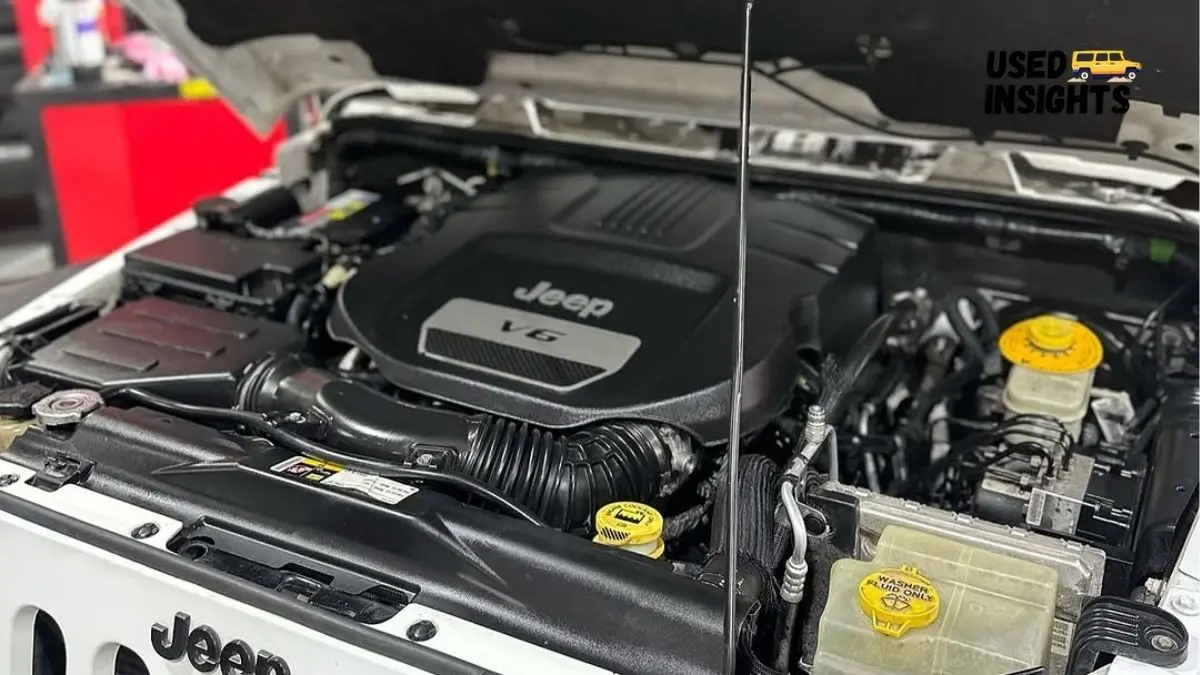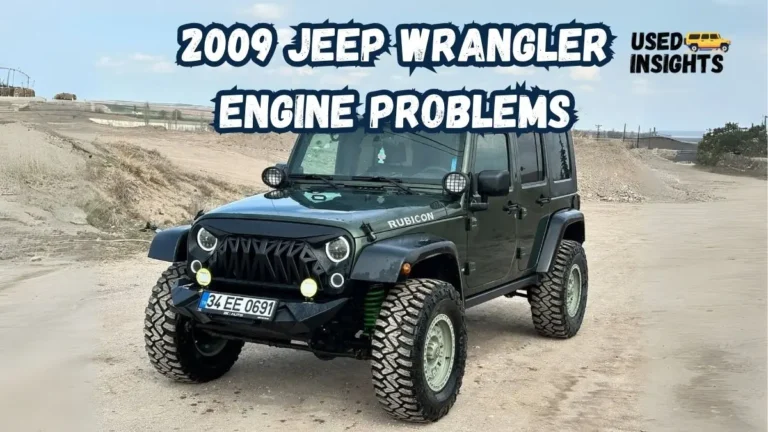Are you considering a 2009 Jeep Wrangler for your next adventure, or are you an owner noticing strange engine behavior? The 2009 Jeep Wrangler, part of the JK generation, is beloved for its off-road prowess and iconic design. However, its 3.8L V6 engine has been associated with several common issues that can impact performance and reliability.
In this comprehensive guide, we’ll dive into the most reported 2009 Jeep Wrangler engine problems, their symptoms, causes, and solutions. Whether you’re troubleshooting or planning a purchase, this article will equip you with the knowledge to keep your Jeep running smoothly.
Understanding the 2009 Jeep Wrangler Engine
The 2009 Jeep Wrangler is powered by a 3.8L V6 engine, delivering 202 horsepower and 321 lb-ft of torque. This engine, paired with either a 6-speed manual or 4-speed automatic transmission, is designed to handle rugged terrains, making it a favorite among off-road enthusiasts.
While the 3.8L V6 is generally robust, it’s not without flaws. Many owners report issues that, if left unaddressed, can lead to costly repairs. Understanding these problems is crucial for maintaining your vehicle’s longevity and performance.

This article will cover the top engine problems, their symptoms, underlying causes, and practical solutions. We’ll also provide preventative maintenance tips and advice for prospective buyers. Let’s get started by exploring the most common issues reported by 2009 Jeep Wrangler owners.
Common Engine Problems in the 2009 Jeep Wrangler
The 2009 Jeep Wrangler’s 3.8L V6 engine has several well-documented issues. Below, we outline the top five problems based on owner reports, mechanic insights, and data from sources like the National Highway Traffic Safety Administration (NHTSA).
1. Excessive Oil Consumption
One of the most frequent complaints is excessive oil consumption. Owners often find their oil levels dropping significantly between changes, sometimes requiring top-offs every 1,000-2,000 miles.
- Symptoms: Low oil levels on the dipstick, frequent need to add oil, engine knocking or ticking noises, and potential check engine light activation.
- Causes: Worn piston rings, valve seals, or gaskets are common culprits. In some cases, the Positive Crankcase Ventilation (PCV) valve may be faulty, contributing to oil loss.
- Impact: Running low on oil can lead to engine wear, reduced lubrication, and, in severe cases, engine failure.
2. Engine Misfiring and Rough Idling
Misfiring or rough idling is another prevalent issue, where the engine struggles to maintain a smooth operation, especially at low speeds or when stopped.
- Symptoms: Stuttering or hesitation during acceleration, rough idling, reduced power, and an illuminated check engine light (often with codes like P0300 for random misfire).
- Causes: Faulty spark plugs, worn ignition coils, clogged fuel injectors, or a malfunctioning throttle position sensor can trigger misfires.
- Impact: Persistent misfiring can damage the catalytic converter and reduce fuel efficiency.
3. Overheating Issues
Overheating is a concern, particularly for Wranglers used in demanding off-road conditions or hot climates.
- Symptoms: High temperature gauge readings, steam from the hood, coolant loss, or a burning smell.
- Causes: A failing thermostat, clogged radiator, coolant leaks, or a malfunctioning water pump are common reasons.
- Impact: Overheating can warp engine components, blow head gaskets, or cause complete engine failure if not addressed promptly.
4. EGR Valve Failures
The Exhaust Gas Recirculation (EGR) valve, designed to reduce emissions, is prone to issues in the 2009 Jeep Wrangler.
- Symptoms: Poor fuel economy, reduced engine power, rough idling, and increased emissions. A check engine light may display codes like P0404 (EGR circuit range/performance).
- Causes: Carbon buildup or a faulty EGR valve can obstruct proper operation.
- Impact: A failing EGR valve can lead to failed emissions tests and reduced engine efficiency.
5. Timing Chain and Tensioner Problems
Some owners report issues with the timing chain or its tensioners, which can cause significant engine trouble.
- Symptoms: Rattling or grinding noises from the engine, especially on startup, reduced performance, or misfiring.
- Causes: Wear and tear, inadequate lubrication, or a defective tensioner can cause the timing chain to stretch or slip.
- Impact: A broken timing chain can cause catastrophic engine damage, requiring extensive repairs.
If yo have a Wrangler of 2006 and causing engine problems, please check 2006 Jeep Wrangler Engine Problems: Symptoms, Causes, and Solutions
Symptoms to Watch For
Identifying engine problems early can prevent major damage. Here are key symptoms to monitor:
- Unusual Noises: Knocking, ticking, or rattling sounds from the engine.
- Warning Lights: Check engine light or temperature warning light activation.
- Performance Issues: Hesitation, rough idling, or reduced power during acceleration.
- Fluid Leaks: Oil or coolant puddles under the vehicle.
- Excessive Oil Use: Frequent need to top off oil between changes.
Using an OBD-II scanner can help diagnose issues by retrieving error codes. Regular visual inspections of belts, hoses, and fluid levels are also recommended. If you notice these symptoms, consult a mechanic promptly to avoid escalating repair costs.
Causes and Risk Factors
Several factors contribute problems to engine problems in the 2009 Jeep Wrangler:
- Poor Maintenance: Skipping oil changes, using low-quality fluids, or neglecting cooling system upkeep can exacerbate issues.
- Off-Road Stress: Frequent off-roading or towing heavy loads strain the engine, especially in extreme conditions.
- High Mileage: Vehicles with over 100,000 miles are more prone to wear-related problems like oil consumption or timing chain issues.
- Manufacturing Flaws: While not widespread, some components (e.g., EGR valves or tensioners) may have had design or material weaknesses.
According to NHTSA, there were no major engine-related recalls for the 2009 Jeep Wrangler, but technical service bulletins (TSBs) addressed issues like misfiring and EGR valve performance. Check Chrysler’s website or NHTSA.gov for updates on TSBs or recalls.
Solutions and Repairs
Addressing engine problems promptly can save you from costly repairs. Below, we outline solutions for each issue, along with estimated costs (based on average U.S. repair shop rates in 2025).
Fixing Excessive Oil Consumption
- Solution: Inspect for leaks and replace worn piston rings, valve seals, or gaskets. Check the PCV valve and replace if faulty. Use high-mileage synthetic oil to reduce consumption.
- Cost: $800-$2,500, depending on the extent of repairs (e.g., gasket replacement vs. engine rebuild).
- DIY Tip: Regularly check oil levels and use a high-quality oil filter.
Resolving Misfiring and Rough Idling
- Solution: Replace spark plugs ($100-$200) and ignition coils ($150-$300). Clean or replace fuel injectors ($200-$500). A mechanic can diagnose using an OBD-II scanner.
- Cost: $100-$800, depending on the component.
- DIY Tip: Spark plug replacement is manageable for DIYers with basic tools.
Addressing Overheating
- Solution: Flush the radiator ($100-$200), replace the thermostat ($150-$300), or repair coolant leaks ($200-$600). In severe cases, replace the water pump ($400-$800).
- Cost: $100-$1,000, depending on the issue.
- DIY Tip: Check coolant levels monthly and inspect hoses for cracks.
Repairing EGR Valve Issues
- Solution: Clean the EGR valve with a carbon cleaner ($50-$150) or replace it ($200-$400). Ensure the EGR system is free of blockages.
- Cost: $50-$400.
- DIY Tip: Cleaning the EGR valve is straightforward with a repair manual.
Fixing Timing Chain Problems
- Solution: Replace the timing chain and tensioners ($1,000-$2,000). This repair requires professional expertise due to its complexity.
- Cost: $1,000-$2,500.
- DIY Tip: Avoid DIY for this repair; seek a certified mechanic.
Using OEM parts is recommended for durability. Always consult a trusted mechanic for accurate diagnostics and repairs.
Summary Table: 2009 Jeep Wrangler Engine Problems and Solutions
| Problem | Symptoms | Causes | Solutions | Estimated Cost |
|---|---|---|---|---|
| Excessive Oil Consumption | Low oil, knocking, check engine light | Worn piston rings, valve seals, PCV valve | Replace rings/seals, use high-mileage oil | $800-$2,500 |
| Misfiring/Rough Idling | Stuttering, rough idle, check engine light | Faulty spark plugs, coils, fuel injectors | Replace plugs/coils, clean injectors | $100-$800 |
| Overheating | High temp gauge, steam, coolant loss | Faulty thermostat, radiator, water pump | Flush radiator, replace thermostat/pump | $100-$1,000 |
| EGR Valve Failure | Poor fuel economy, rough idle, emissions | Carbon buildup, faulty valve | Clean or replace EGR valve | $50-$400 |
| Timing Chain Issues | Rattling noises, misfiring, low power | Worn chain, faulty tensioner | Replace chain and tensioners | $1,000-$2,500 |
If yo have a Wrangler of 2017 and causing engine problems, please check 2017 Jeep Wrangler Engine Problems: Common Issues, Symptoms, and Solutions
Preventative Maintenance Tips
Preventing engine problems is more cost-effective than repairing them. Follow these tips to keep your 2009 Jeep Wrangler’s engine in top shape:
- Regular Oil Changes: Change oil every 5,000-7,500 miles using synthetic 5W-20 oil. Check oil levels monthly.
- Cooling System Care: Flush the radiator every 2 years or 30,000 miles. Inspect hoses and coolant levels regularly.
- Spark Plug Maintenance: Replace spark plugs every 30,000-50,000 miles to prevent misfiring.
- EGR Valve Cleaning: Clean the EGR valve every 50,000 miles to avoid carbon buildup.
- Monitor Driving Habits: Avoid excessive idling, overloading, or aggressive off-roading without proper maintenance.
- Follow Maintenance Schedule: Adhere to Chrysler’s recommended service intervals (available in your owner’s manual).
Investing in routine maintenance can extend your engine’s lifespan and reduce the likelihood of major issues.
Should You Buy a 2009 Jeep Wrangler?
The 2009 Jeep Wrangler remains a solid choice for off-road enthusiasts, offering unmatched capability and a timeless design. However, potential engine problems require careful consideration. Here’s how to make an informed decision:
- Pros: Excellent off-road performance, strong resale value, customizable design.
- Cons: Engine issues like oil consumption and misfiring, lower fuel economy (15-20 MPG).
- Buying Tips:
- Check vehicle history reports (e.g., Carfax) for maintenance records and accident history.
- Have a pre-purchase inspection by a certified mechanic, focusing on the engine and cooling system.
- Prioritize low-mileage Wranglers (under 100,000 miles) with documented maintenance.
- Verify if TSBs or recalls have been addressed.
If you’re prepared to invest in maintenance, the 2009 Jeep Wrangler can be a rewarding vehicle. For peace of mind, consider extended warranties for high-mileage models.
Conclusion
The 2009 Jeep Wrangler is an iconic vehicle, but its 3.8L V6 engine has its share of challenges. From excessive oil consumption to timing chain issues, owners and buyers must stay vigilant. By recognizing symptoms, addressing problems promptly, and following a strict maintenance schedule, you can keep your Jeep running reliably for years to come. Whether you’re troubleshooting an existing issue or researching a purchase, this guide provides the tools to navigate 2009 Jeep Wrangler engine problems with confidence.
Additionally, You can also like and, follow us on Pinterest, and Reddit for more updates. Your thoughts and engagement are greatly appreciated and find more info in the Jeep section!


1 comment